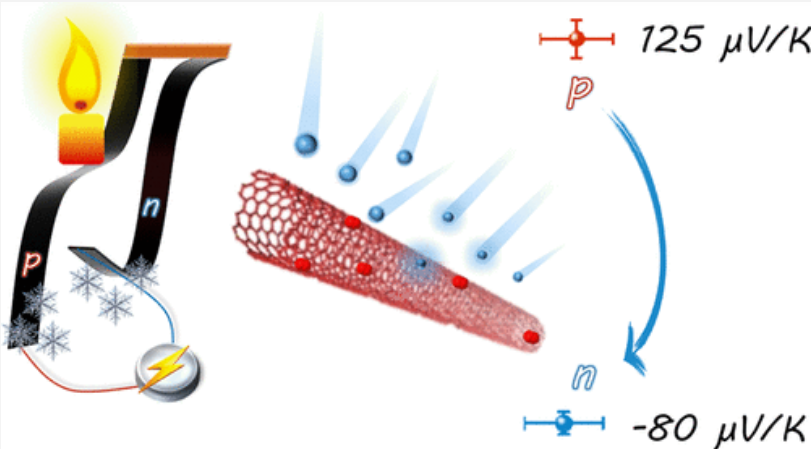We explore an n-type doping strategy of semiconducting single-walled carbon nanotubes (sc-SWCNTs) by a covalent functionalization in ammonia plasma and elucidate the effect of air exposure on thermoelectric properties of the sc-SWCNTs before and after doping. Without doping, the sc-SWCNT films have a Seebeck coefficient of 125 μV/K and a power factor (PF) of 95 μW/m K2 in ambient conditions. Heating of such films in air up to 100 °C and above is not changing their thermoelectric properties noticeably; however, the films can be converted to an n-type material simply by gas desorption at low pressure and room temperature, showing an outstanding negative Seebeck coefficient of -133 μV/K and a PF of 55 μW/m K2. Doping of the sc-SWCNT films with ammonia plasma leads to the reduction of the Seebeck coefficient down to 40 μV/K in ambient conditions, which is the result of two competing effects: attachment of electron-donating functional groups during plasma treatment and adsorption of water molecules when exposing films to air. At temperatures slightly higher than the boiling point of water, the doped films of sc-SWCNTs show the lowest Seebeck coefficient of -80 μV/K in air. A similar value of the Seebeck coefficient is obtained for the same films at low pressures and room temperature. To our knowledge, this is one of the best values ever reported for n-type pure carbon nanotube films.

We explore an n-type doping strategy of semiconducting single-walled carbon nanotubes (sc-SWCNTs) by a covalent functionalization in ammonia plasma and elucidate the effect of air exposure on thermoelectric properties of the sc-SWCNTs before and after doping. Without doping, the sc-SWCNT films have a Seebeck coefficient of 125 μV/K and a power factor (PF) of 95 μW/m K2 in ambient conditions. Heating of such films in air up to 100 °C and above is not changing their thermoelectric properties noticeably; however, the films can be converted to an n-type material simply by gas desorption at low pressure and room temperature, showing an outstanding negative Seebeck coefficient of -133 μV/K and a PF of 55 μW/m K2. Doping of the sc-SWCNT films with ammonia plasma leads to the reduction of the Seebeck coefficient down to 40 μV/K in ambient conditions, which is the result of two competing effects: attachment of electron-donating functional groups during plasma treatment and adsorption of water molecules when exposing films to air. At temperatures slightly higher than the boiling point of water, the doped films of sc-SWCNTs show the lowest Seebeck coefficient of -80 μV/K in air. A similar value of the Seebeck coefficient is obtained for the same films at low pressures and room temperature. To our knowledge, this is one of the best values ever reported for n-type pure carbon nanotube films.
